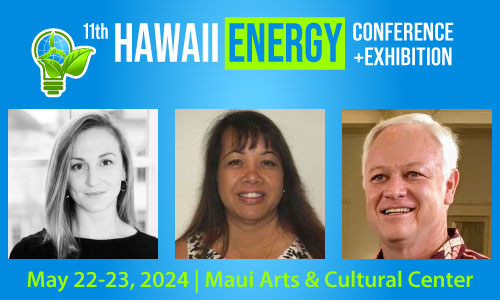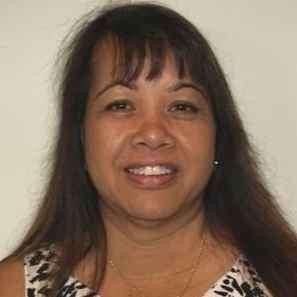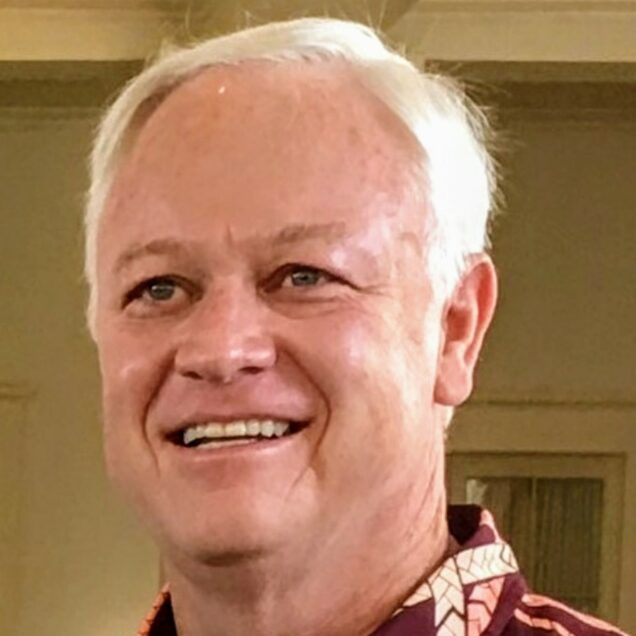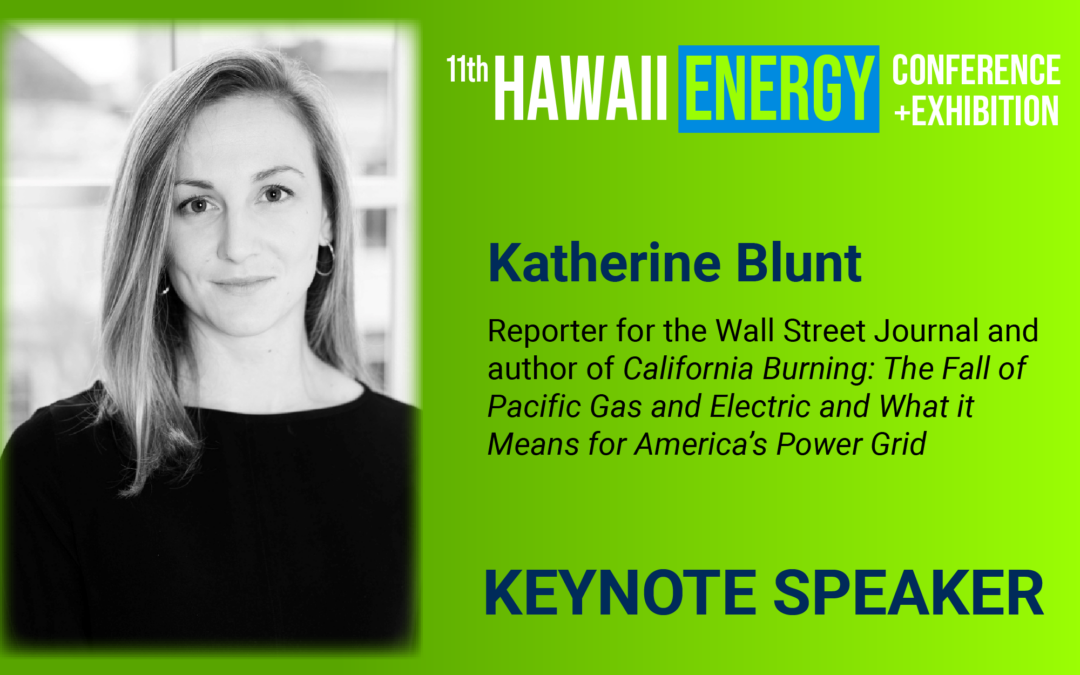
Hawaii Energy Conference Reimagines Resilience
On May 22-23, Maui Economic Development Board (MEDB) presented the 11th Annual Hawaii Energy Conference (HEC), with the theme Reimagining Resilience, at the Maui Arts & Cultural Center. Supported by the County of Maui Office of Economic Development, the HEC brought together experts and thought-leaders to connect with each other and explore the latest advances shaping the energy landscape world-wide.
The conference drew participation from Hawaii, the Continental U.S., Canada and Korea, for discussions on risk management, grid stability, and adaptive solutions that ensure a reliable and resilient energy supply.
Given the recent global trend of extreme weather events increasing in frequency and severity, the panels, case studies, and exhibit venue all addressed cutting-edge solutions to support resilience while lowering carbon emissions. Also included was how resilience planning can prioritize historically marginalized and disadvantaged communities.
“The Hawaii Energy Conference is more important than ever this year because of its topic of resilience,” said Leilani Chow, Energy Program Manager, Sust’āinable Moloka’i who spoke on a panel on the Thursday morning. “When you do community planning, resilience is at the forefront of community life. It is one of the huge topics that community leaders need to bring to the table for the well-being and safety of the people, no matter the disaster scenario.”
“The Maui wildfires helped us realize how vital planning for disasters is and that it must be accounted for in all of our energy preparation from the beginning. The conversations here helped us to better understand that this kind of planning needs to be done in other communities as well.”
Keynote speaker, Author and Wall Street Journal reporter Katherine Blunt kicked off the conference, sharing her research and insights from the California wildfires, the fall of PG&E, and her book California Burning: The Fall of Pacific Gas and Electric and What it Means for America’s Power Grid.
“It’s not just California and Maui, but also other places across the country, including Canada, that are facing possible fires and other disasters,” said Blunt. “We are facing a disruptive future that is likely to include big rate hikes, electric power instability, rolling blackouts and physical danger. All states might want to pay closer attention to the long-term effects of climate change with ambitious renewable energy mandates.”
During an ensuing discussion moderated by Doug McLeod, HEC program committee member, with Colton Ching, Senior Vice President, Planning & Technology, Hawaiian Electric, Blunt added, “The California story began as an article but was so complex it grew into a book. The Lahaina story is also complex. In many ways it is similar, but also unique.
“It takes a long time to make infrastructure changes, and costs could rise as more fires break out. Climate change, reflected in drier and hotter weather and more combustible vegetation, adds to the risks.”
“None of this can be fixed overnight. This is a wake-up call that utilities need to do more to minimize the risks. The take-away is that it is an issue everywhere across the country and the risks need to be mitigated through different pathways such as legislature, investor models to run a business, and much more.”
Colton Ching, responded, “The risk for the utilities is always there, especially in an environment that is always changing. Plus, it exists no matter who owns the assets. We need to be financially healthy with capital for improvements.”
Another featured speaker on Day 1 of the Hawaii Energy Conference was The Honorable Josh Green, Governor, State of Hawaii. Speaking of the challenges that persist after the August Maui wildfires, he said, “We need light speed changes for Hawaii. Many people had to leave the island. We have to change that. To start, lower taxes for working families would be more than helpful. We are currently the second highest taxed state in the country. Long-term and short-term rental changes could make a big difference as well.”
“Our energy goals for 2045 are extraordinary. We need money and investors to help solve the future clean energy challenges. The good news is we can do it; the bad news is we may have to take something away.
“We must support HECO and not let it collapse. We need local control of energy production, distribution, and securitization for the bridge to 2045. The bridge should be healthy and economically creative to get to 60% of our goal in the next six years.”
Looking for input and support, Green pleaded, “We need more plans to reduce our carbon emissions for our clean energy future. I’m counting on the thought leaders at the Hawaii Energy Conference to do what is best for our communities, while helping to keep costs down.”


…
Networking
In addition to the general sessions, the conference also provided networking opportunities for attendees with breakfast, lunch and receptions included. There was high energy in the exhibit venue with the opportunity for attendees to connect with each other and with participating sponsors showcasing the latest renewable-energy technologies and services.
“This is a great conference to always catch up with everyone,” added Noe Kalipi, Chief Strategy Officer and EVP Hawaii & Pacific, Progression Offshore. “It’s great networking. I can achieve in one morning what might take me weeks to do.”
“Resiliency is more pertinent for Hawaii now because we have the science and technology. We need to get things done, even with limited resources. If we study the past and look at the science behind everything, we can apply it to what we need today to help us move forward. The Hawaii Energy Conference is where we have a broader conversation with many perspectives and a willingness to work with people.”
Shayna Decker, Hawaiian Electric shared, “I think the conference is important because it allows us to meet face-to-face and in-person with people from all different areas and technologies in the industry. I have attended all 11 years and value the evolution of discussions, and the projects that materialize from working and collaborating together.”
David Sellers, Principal Architect, Hawaii Off Grid Architecture & Engineering, emphasized, “The great thing is the conversations that are happening and the connections that people are making. It is extremely important to have these conversations; to talk-story and to learn from each other. Resiliency is something we lost sight of, but now we have to make things happen to help people who cannot mitigate these problems themselves. It’s time to move forward. Let’s do it!”
Gary Huffman of Burns & McDonnell, a sponsor and exhibitor noted, “At the Hawaii Energy Conference, I get to meet everyone in the industry, and everyone is brought to the table, all stakeholders, which gives a greater perspective as to what can be accomplished working together.”
Gabe Johnson, Maui County Council, Lanai District, shared, “I’m here to learn about alternate ways to address our energy consumption. We are looking at a smaller grid for communities as a way forward and another idea might be a co-op. We (Maui) have the most expensive rates in the state, and we have to come up with other ways to address that.
Hannah Shipman-Peila, Hā Sustainability, said, “I’m here to network with other professionals in the industry and to learn more. This is my favorite conference to attend because it is always so well presented, the speakers are incredible, the panels are great, and people ask the most amazing questions. It is one of the only conferences that has all the energy people in the state in one space to network and redevelop relationships.”
The conference closed with a final networking opportunity; a Pau Hana reception sponsored by Women in Renewable Energy (WIRE). WIRE’s mission, to advance the role and recognition of women and other under-represented groups working in the energy sector, includes all renewable-energy and clean-energy technologies. The Pau Hana event featured live music with band Nevah Too Late.
The 2024 Hawaii Energy Conference was sponsored by Ulupono Initiative, Hawaii Natural Energy Institute (HNEI), Ulupono Initiative, HNEI, Aukahi Energy, Burns & McDonnell, Hawaii Energy/Leidos, Hawaiian Electric, IBEW Local Union 1186, Island Energy Services, Moss & Associates, Par Hawaii, TerraForm Power, AES, Canadian Solar, Generac, Hawaii Gas, HNU Energy, J&M Distributed Solutions, Jurchen Technologies, Kauai Island Utility Coop, NovaTech, Pacific Panel Cleaners, Puna Geothermal Ventures and Trio Energy Alliance.
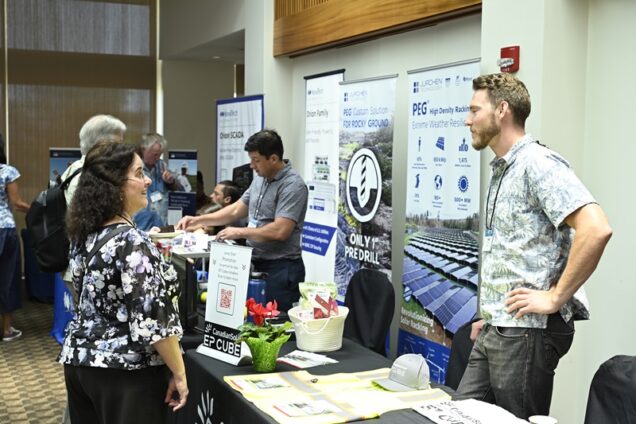
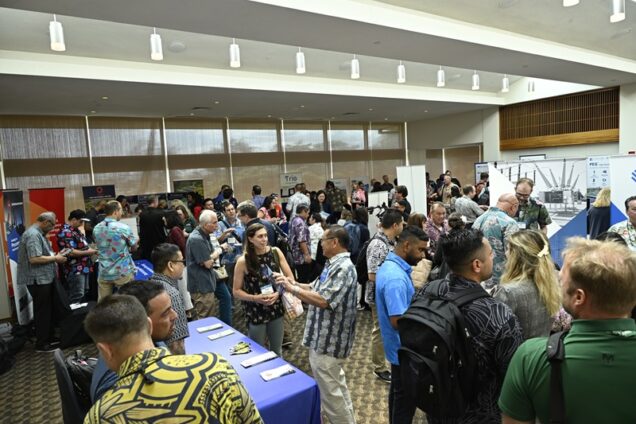
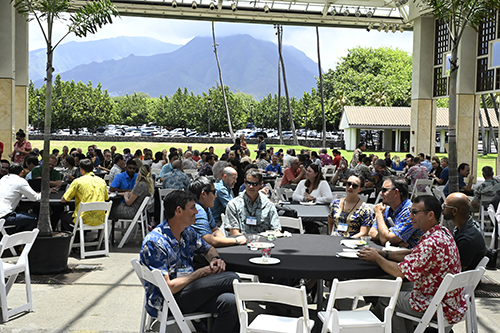
Networking opportunities at the 2024 Hawaii Energy Conference
SUMMARY OF PANELS AND INVITED TALKS
Day 1
PANEL 1 | FUELING THE FUTURE
The panel discussed understanding the differences between biodiesel, renewable diesel, renewable natural gas, and other biofuels. Can these fuels really help with resilience and do they lower carbon emissions?
Moderator of the panel, Julie Yunker,Director of Sustainability, Government and Community Affairs, Hawaii Gas; said, “Our Sustainability Committee focuses on several initiatives, including a greenhouse gas emissions inventory to establish reporting baselines and to support emissions reduction targets.”
Bob King, Founder & President, Pacific Biodiesel, said “Our company has always focused on recycling with a zero-waste philosophy that incorporates development of value-added co-products. Our collaborative community-based agriculture and energy production model demonstrates a full-circle system of sustainability and climate change solutions designed to help Hawaii achieve a clean, sustainable energy future.
“A preliminary USC report on Life Cycle Assessment of electric bus versus biodiesel buses in Hawaii shows that biodiesel buses demonstrate a substantial reduction in environmental impact, consuming 48% less energy and 89% less water, compared to their electric counterparts.
Jon Mauer, President & CEO, Island Energy Services, commented, “One of IES’ core strategies is working to help the State of Hawaii transition to more sustainable fuels for the future, because Hawaii’s effort to decarbonization will require a portfolio of renewable energy, which includes biofuels.
“Hawaii’s RPS (Renewable Portfolio Standards) requirements for power generation are already driving renewable energy investments, recognizing that power resiliency and reliability will be critical.
“A State and Federal legislative framework that enables investments and sources of fuels for the State of Hawaii’s energy needs will be required. For example, the Low Carbon Fuel Standard and both local production and imports of fuel will need to be included.
“Hawaii’s biofuel transition is happening now, but more work is required. Stakeholders understanding of fuel and energy alternatives to meet their specific objectives will be important to get this right.”
Nicolas Rodier,Executive Director of Clean Energy and Innovation, Hawaii Gas, added, “Hawaii Gas is the state’s only regulated gas utility overseeing diverse sustainability initiatives. We are committed to reducing the carbon intensity of our system.
“Renewable natural gas and green hydrogen from solar are both intermittent, depending on variable factors like the sun, heat, and humidity. To remain reliable, we must be able to deal with volatility by diversifying our fuel sources, leveraging our existing assets, and using our renewable fuels, such as renewable naphtha.
“The path forward is to decarbonize our system. We need to maintain the same level of reliability and progress with our fuel substitution and diversification plans. We are firm in our commitment to a sustainable and energy-resilient Hawaii.”
Eric Wright, President, Par Hawaii, said, “Liquid renewable fuels are critical to Hawaii’s decarbonization goals. Par’s Renewable Hydrotreater (RHT) Project is a $90-million project to produce renewable fuels at our Kapolei refinery. Feedstocks include biogenic fats, oils and greases to produce low carbon jet and utility fuels for Hawaii, starting in 2025.”
“Our objective is to source local feedstock for a portion of production because feedstock supports agriculture and increases our energy security. We are conducting oil seed field trials in Hawaii through partnership with Pono Pacific.”
“State and Federal credits bridge the gap between conventional renewable fuel and alternatives. Par is working with Hawaiian Airlines, Pono Pacific and other stakeholders on a legislative proposal to increase the Hawaii Renewable Fuels Production Tax Credit.”
All panelists agreed, “The legislature needs to create incentives to offset higher unit costs of biofuel compared to standard petroleum.”
PANEL 2 | RESILIENCE FOR VULNERABLE POPULATIONS
This panel discussed protecting vulnerable populations, including design of local microgrids, planning for distributed energy resource (DER) systems, and implementing public-safety power-shutoff (PSPS) plans.
Maria Tome, Managing Director, Energy Efficiency and Renewable Energy, Hawaii State Energy Office, moderated the discussion, saying, “It is vital for stakeholders working for resilience in vulnerable populations to work directly with project developers, such as permitting and regulatory agencies, utilities, the local and national industry, environmental and community experts on statewide energy strategies, resource assessments, policy analyses, environmental assessments, and technical and economic evaluations. Basically, the whole industry must work together to get it right.”
Michael Angelo, Division of Consumer Advocacy, Department of Commerce and Consumer Affairs, State of Hawaii, contributed, “We need advocacy in the regulatory environment and affordability in clean energy transition. Resilience for vulnerable populations is vital, for example when designing microgrids, and when planning for distributed energy resources and rooftop solar photo-voltaic systems.
“PSPS, when electric utility temporarily turns off power for fire risk areas, intends to reduce fire risk from electric power to fire risk areas. It is typically triggered by risk-based conditions, such as windand extreme dry conditions. PSPS has many side effects on users. Some solutions for those side effects are needed until power is restored. Provisions of other utility services are needed, such as electrical life support equipment, and day-to-day life needs, including cold storage, cooling and lighting.
Beth Amaro, Member Services and Communications Manager, Kauai Island Utility Cooperative, said, “We must stay current with available technologies for maintenance and preventive measures. We are working on demonstration projects to boost reliability and support our utility’s goal of reaching 100% renewable energy withing 10 years.
“Resilience hubs that are publicly accessible locations are needed during adverse conditions. Microgrids designed to benefit all consumers include DERs as a potential solution as part of a resilience hub.”
“In order to prepare the Kauai cooperative for PSPS we use pole inspections by drones with high resolution cameras, distributed weather stations, and Thor’s Hammer, a quick nondestructive test of utility pole integrity that can be repeated over many cycles with zero risk of shortening the serviceable life of the pole, to get local real-time assessment for PSPS..”
Ben Ollis, R&D Associate, Oak Ridge National Laboratory, shared, “The cost of not investing in PSPS mitigation can be very high. Metrics for assessing resilience can be very diverse; we must make sure the right metric has been used for planning investments.
“In Puerto Rico there needs to be resilient community microgrids to deal with long-term outages, such as with hurricane damages. Case studies show that microgrids can be joined to provide affordable and reliable access to electricity in a town square in Puerto Rico. Networking the grids would increase their resiliency metrics while operating as an island.”
“However, microgrid integration of parts from different suppliers can be a barrier to implementation. Standardization among manufacturers and vendors is needed.”
PANEL 3 | POWERING PROGRESS: WHAT IS NEEDED FOR A RESILIENT AND DYNAMIC ENERGY FUTURE
Perspectives were discussed on what has been achieved and what gaps need to be filled to ensure continued progress for Hawaii.
Michael Colón, Energy Director, Ulupono Initiative moderated this session, saying, “Ulupono spearheads efforts that align with the firm’s vision for a community-driven, clean-energy future for Hawaii. We need to know where to go next to empower our communities through sustainable energy solutions. It’s vital to support the continued growth of clean energy in the state by supporting conscious and community-engaged action.”
Caroline Carl, Executive Director, Hawaii Energy, stated, “Demand is my issue and figuring out mechanisms for community engagement. Households need to be conscious of our energy goals day-to-day. Residential loads are easier to manage in Hawaii because of our climate so we need to design and implement innovative initiatives to help achieve energy savings targets, while helping families and businesses save money and make smart energy choices.
“Enhanced building codes for better efficiency leads to larger up-front costs but lower operating costs,” Carl added. “It is more desirable that the market does this than the government. It will be much cheaper. At the end of the day, for international and national building energy codes, the market needs to be more resilient and more efficient to adopt best practices for our infrastructure.”
Mark Glick, Chief Energy Officer, Hawaii State Energy Office, commented, “I would like input from all voices in our community because community-driven planning is changing the game. It can help ensure resilience. We need to coordinate with the Legislators to oversee the fulfillment of Hawaii’s ambitious energy transformation.”
“We need more planning to prepare for weather related events. The biofuel sector is reliable but still a small percentage of green energy. Legislators need to rethink and expand development of geothermal.”
“We need to make more capital available for renewables and reduce costs in a way that will attract capital investments. Moloka’i is a great model for this and perhaps we can take pieces of that to other communities, moving forward.
“I’m hopeful that the state will receive a $250 million award from the Department of Energy for the installation of temperature sensors, high-tech weather stations and other strategies to harden the grid and increase Hawaii’s resilience to climate change impacts.”
Colin Yost, Commissioner, Hawaii Public Utilities Commission (PUC), contributed, “The PUC is considering changes in practices due to climate change. We are keeping a sense of what is important to get to 60% of the 2045 goal and reassess the best way ahead.”
“We want to try to implement new technologies quicker and create a more reliable energy system. Engaging with the community takes time and we need to move at the speed of trust due to the increased demand for distributing load in the future.”
“Communities are stuck in reaction mode rather than thinking ahead proactively. Less advantaged communities still need access to rooftop solar. Electric-vehicle infrastructure is woefully behind.”
“We need to improve permitting time so that everyone who can contribute to our goals can do so. Everyone has the potential to help us move forward in our sustainable future.
“Kauai has demonstrated an extraordinary achievement with the lowest costs in the state and I think we should be able to achieve that in the rest of the State. We need to know what legislative measures are most desirable now.”
The Honorable Josh Green, Governor, State of Hawaii joined the panel and said, “We need some form of securitization to cover electric utility costs in the near term. We need to bring in more equity to bring net costs down, for example, green fees, or travel fees. We can tell people they are contributing to global goals.
“We can’t do nothing! Community engagement on 2045 goals can happen in parallel with most state processes. We are the pioneering state for a 100% Renewable Portfolio Standards and are committed to eliminating our dependency on imported fossil fuels by 2045.
“Legislators need to be informed about the true community positions on issues. There are no shortcuts to 2045. It is good for people to move away from fossil fuels that are destroying our planet. We also need the political will to do it.”
“HECO needs support from the community to survive. Economics will eventually favor renewables, and we need to persevere until then. The electric company has mandated detailed analysis of each energy source. We need to have all renewables on the table.”
“We need some common ground in our efforts to agree to work through the hard nitty-gritty of every day. Waiting has a cost, including human cost.”
FEATURED PRESENTATION: A Fire Safety Professional Looks at Battery Fires
Kazuo Todd, Fire Chief, Hawaii County Fire Department
“The main cause of fires is damage to batteries, which can become very hot and produce toxic gases. Battery technologies being deployed in Hawaii are battery energy storage systems (BESSs), electric vehicles (EVs), residential systems, and consumer products. The common cause of risks are lithium battery fires.
“Potential hazards during fires are toxic fumes and explosions. Improper disposal can also lead to fires. Our firefighting concerns include effective suppression techniques and agents. New batteries can require excessive amounts of water and time to put out.
“EV battery fires can re-ignite up to a week after a collision, causing toxic gases, electrocution, heat, and explosions. Consumer prevention and safety measures include proper charging, following manufacturer’s guidelines, and being aware of knock-off batteries and unlisted products.
“Our BESS emergency response preparedness incorporated essential firefighting equipment and protective gear, specialized training and regular drills, plus developing comprehensive emergency response plans. Also, we have regulatory and industry standards for BESS.
“We recommend becoming involved with the local fire response in the planning stages for BESS and considering statewide disposal processes. The frequency of fires is not more than with other technologies but concerns over the unfamiliar and new suppression needs are being taken seriously.”
PANEL 4 | RESILIENT SOLAR
Innovation in residential solar. What are the installers in Hawaii doing to meet the needs of their customers? What are some island-by-island differences?
Moderator, Robert “Rocky” Mould, Executive Director, Hawaii Solar Energy Association (HSEA) said, “Private rooftop solar systems are 47% of Hawaii’s solar capacity and play an important role for a sustainable and resilient Hawaii.
“The HSEA works directly with industry, regulators, policymakers, and other stakeholders to drive Hawaii’s clean energy transformation by creating green jobs, advancing solar energy and energy storage solutions, and providing resilient alternatives for Hawaii’s community.
Fred Brooks, Owner, Pacific Panel Cleaners (PPC), shared, “PPC is a solar panel cleaning and maintenance company. Twelve percent of the systems installed are not working. This fosters recycling of defunct panels rather than disposal. Drones help us on big sites to identify issues fast.”
“The message is: Keep those panels clean! Soiling can rob a panel of 20% of its efficiency. We have seen even more extreme cases. It’s not just that dirty panels will seriously lower efficiency but whatever impairs them, such as uric acid in bird droppings or salt in our island air, which also takes its toll on the aluminum panel frames, exposed pipe work, and external wiring. All of these, when damaged can distort the system’s essential balance.”
Ted Peck, President, Holu Hou Energy (HHE), asked, “How do you size a system for low or intermittent loads, as with small apartments or vacation rentals, when you can’t export the instantaneous excess generation? One answer is, you can share among a set of such units, allowing a more predictable total load.”
He continued, “Time of day, generation versus consumption mismatch, and time load is never predictable in a rental property unit. Also, exported energy is less and less valuable because excess production needs to be stored to create value, making the load risk problem even worse.
“A case study at the Makai Kalaeloa MDU Project in 2016-2017 showed an initial experience with MDU solar only via PPA (Power Purchase Agreement) with a facility owner. The problems encountered at Makai brought invaluable learning that was foundational to creating the HHE EnergyCluster concept.
“The mismatch between supply and demand for MDU properties makes standard photovoltaic (PV) + storage systems impossible to economically size. However, EnergyShare Technology smooths out the wide variance of load and makes a more predictable load profile creating a highly robust PV + ESS (Energy Storage System).
“Energy management, efficiency and renewable energy are vital to the unique challenges of Hawaii’s landscape.”
Jamie Swezey, Program Director, Footprint Project commented, “Our mission at Footprint is to build back greener after disasters by providing cleaner energy infrastructure to communities in crisis. Our overall impact to date includes 20+ disaster missions, 250+kW of mobile solar, 700+ kWh of mobile battery storage, and 50,000 people supported with emergency sustainable energy access.
“We believe the best way to develop new resilient infrastructure is to build it together. Through our numerous partnerships we assemble off-grid mobile solar generators for community-based disaster relief. We train, educate, and empower communities to safely deploy and plug into cleaner energy systems.
“The devastating wildfires led us to our largest disaster response and recovery mission to date. The power of partnership between community and industry is lighting the path toward resilience on Maui.”
PANEL 5 | USING VIRTUAL POWER PLANTS TO SUPPORT RESILIENCE
A discussion of Virtual Power Plants (VPPs) and the new Hawaii Bring Your Own Device (BYOD) program. The panel discussed the recent VPP Commercial Liftoff Report from the US Department of Energy, lessons learned in Hawaii from the successes of the Battery Bonus Program, and challenges as we move ahead under the new BYOD Tariff. The panel also premiered a VPP Model Tariff and Legislation.
Moderator, Bradley Albert, Director of Business Development, Nexamp, said, “In November 2022, Hawaiian Electric awarded Nexamp seven solar projects to benefit low and moderate income customers on Maui, Oahu, and Hawaii Island.”
“Hawaii does not need permit controls for electric vehicles; heating, ventilation and air conditioning; hot water; and battery storage. Once solar is installed, these control techniques are automatically available.”
Beren Argetsinger, Partner, Keyes & Fox LLP, commented, “Virtual Power Plants are operating in many states. They are not all the same. Current VPP programs continue to be modified as experience accumulates. Hawaii is uniquely positioned to enable VPPs at scale. Some other VPP programs across the country include California, Colorado, Connecticut, Hawaii, Massachusetts, New York, Rhode Island, Utah, and Vermont.
“Hawaii is uniquely positioned to enable VPPs at scale. We have a high penetration of customer-sited solar + energy storage; aggressive climate and clean energy goals, near-term capacity needs, resiliency needs, and cost reductions. Customers subscribe and are paid a fee to allow their energy resources to be used on the grid.”
“VPP takeaways: simplicity, meaningful customer value proposition, ratepayer benefits, and participation of DER industry partners are all crucial elements of the programs’ success.
“The Model VPP Tariff Initiative is a standard offer with open-access tariff-based VPP framework building on the DOE Liftoff Report, which includes recommendations and best practices from VPP programs operating around the country.
Richard Matsui, Senior Advisor, DOE LPO (Department of Energy Loan Programs Office) added, “Between 2023 and 2030, coincident peak demand on the grid will rise ~60 GW. At the same time, fossil assets are retiring. Roughly 200 GW of peak-coincident demand must be served with new resources coming online by 2030.
“Each year, electric-vehicle chargers and batteries will add 20-90 GW of demand and 305-540 GWh of storage capacity.
VPPs provide resource adequacy at a low cost, build resilience, reduce missions, alleviate power grid congestion, and empower communities. One critical function of VPPs is to use distributed energy resources (DERs) to reduce demand peaks.
He concluded, “Five imperatives will accelerate Liftoff for VPPs: expansion of DER adoption with equitable benefits; simplifying VPP enrollment; increasing standardization in VPP operations; integrating VPP into utility planning and incentives; and integrating VPPs into wholesale markets.”
Wil Yamamoto, Partner, Yamamoto Caliboso Hetherington said “Early Hawaii VPPs helped grid stability by reducing home and business consumption. Power Partnership Programs with independent companies or grid-service aggregators provided grid services by managing customers’ systems to help balance supply and demand.
“The Battery Bonus Program (cash incentives for adding new energy storage to a rooftop solar system) improved grid reliability and resiliency during evening peak hours and encouraged customers to add energy storage to their existing or new rooftop solar.
“The BYOD-1 program is a follow-up program launched in April 2024 with three levels of BYOD planned for the installation of new energy storage batteries or other smart technology, with upfront and monthly incentives.
“BYOD-2 and BYOD-3 are in development, intending to offer remote dispatch and control capability, with aggregators as dispatch agents, versus utility direct dispatch.
“As currently defined, participants are limited to utility customers who can receive on-bill credits. There is no mechanism to provide program payments to aggregators at this time.
“Ultimately, if VPPs are to gain wide adoption and become a true grid resource, customers will need to be sufficiently incentivized to participate. In the long run, grid value of energy must match customer value of the battery capacity made available: customers don’t want to ‘sell low and buy high’. Hawaii’s experience has national attention.”
DAY 2
PANEL 6 | CENTERING EQUITY IN RESILIENCE PLANNING
Resilience planning must be culturally appropriate, participatory, and responsive to local needs. This panel explored successful efforts to prioritize equity in efforts to build resilience in our infrastructure, natural systems, social systems and communities.
Jonathan Koehn, Director, City of Boulder Climate Initiatives Department and a founding member of the HEC Program Committee led this discussion to open Day 2 of the Hawaii Energy Conference.
“Prioritizing energy resilience within our homes, businesses, communities and industries is critical for maintaining a reliable, accessible supply of energy while also limiting system vulnerabilities to increasing natural disasters. Resilient energy systems can also improve health, comfort, affordability and accessibility.
“We must also address problems related to more vulnerable people and design systems that include everyone.”
“Government needs to listen to information they did not solicit. Typically, government is good at pushing information out but not good at accepting information it did not seek.
“Communities also need to do their own resilience planning and present it to the government for implementation.”
Leilani Chow, Program Manager, Sust’āinable Moloka’I said, “We were established in 2010 after the breakdown of master land-use conversations between the community and the developers of Moloka’i Ranch. This experience profoundly impacted the community—some were for the proposed land trust, and some were against it.
“The one thing that could be agreed upon was that we needed to be drivers of our destiny as a community to shape growth that aligns with our cultural values. This is the reason and purpose for Sust’āinable Moloka’i. We are proud to work to ensure that our community’s voices and mana’o are incorporated into collective decisions about the future of our land.
“Energy planning often does not consider the voices of ordinary citizens. Resilience needs to be at the forefront of planning for the needs of the community.
Yesenia Perez, Climate Equity Program Manager, Greening Institute commented, “At Greening, we are a team of equity-focused optimists who are building a future where race is never a barrier to opportunities and where communities of color can thrive.
“Development and implementation of climate resilience and clean mobility policies must ensure that they effectively address the needs of everyone.
“Historically, solutions led by local stakeholders exclude a community-driven approach. Many times, experts come with technical solutions without hearing from the community affected. It is up to the communities to decide for themselves what they need and want.
“Funding for transportation also needs to be distributed with equity. Certain communities of underserved are left out of improvements.”
Bethel Tarekegne, System Engineer, Pacific Northwest National Laboratory, added, “We need to focus on understanding the social equity implications of renewable energy technologies. We must also explore justice implications; discovering ways that will also benefit underserved communities.
“The convening power of the government needs to be used to help local communities meet and articulate what their needs are. Communities need a stake in the ownership of the energy solutions developed for them.”
FEATURED PRESENTATION | EXPLORING PUBLIC OPINION: COMMUNITY SENTIMENT TOWARD RENEWABLE ENERGY TECHNOLOGIES
Murray Clay, President, and Michael Colon, Energy Director of Ulupono Initiative presented results from a survey.
“Ulupono Initiative sought to test assumptions about public perception of renewable energy projects and gather insights to help shape Hawaii’s energy future alongside its communities,” said Clay. “This is the most extensive and comprehensive public opinion survey on the topic of energy in Hawaii. The survey was designed to rank how residents view various energy technologies with 1,985 surveys of full-time Hawaii residents, age 18+.”
Colon added, “The nearly 2,000 people were surveyed on their thoughts about geothermal, utility-scale solar, land-based wind, offshore wind, hydroelectric, biomass, and fossil fuels.”
Results presented by the pair were:
- A statewide average of 91% of survey respondents said that in general they support the expansion of renewable energy resources in Hawaii. The County of Hawaii was ranked the strongest, the lowest was Honolulu.
- 71% said that, in their opinion, it is very important for Hawaii to develop its own renewable sources of electricity. An additional 25% said, ‘somewhat important’. The County of Hawaii had the largest percentage of those saying, ‘very important’.
- According to respondents, the most important factor in deciding what type of energy generation technology is developed in Hawaii is one that produces inexpensive electricity.
- The County of Hawaii saw the strongest support about a utility-scale geothermal power plant being built in their town or community. However, all agreed to support it if it lowered their electric bill by at least $30 each month and would not harm the environment.
- Sixty-five percent of respondents agree that residents must contribute in some way to the expansion of renewable energy to make an impact on climate change.
The full survey is available at https://ulupono.com/project-list/statewide-energy-survey/
PANEL 7: | WORKFORCE DEVELOPMENT AND ENERGY RESILIENCE
Moderator Damien Kim, Business Manager and Financial Secretary, International Brotherhood Electrical Workers (IBEW) Local 1186 led a discussion that explored the question, ‘Do we have the labor force we need to increase resilience?’
“IBEW is a nonprofit labor organization of electrical workers with common concerns and aspirations for a better Hawaii workforce. Local IBEW and our certification and apprenticeship programs provide a way for labor to stay in Hawaii. We provide an alternative pathway to pursue for those not going on to college.”
“The construction industry is second behind tourism in Hawaii. We know that by working together we can accomplish what we cannot accomplish alone. We serve as a vehicle to bring together people of many talents to achieve service to the community.”
Terry Uyehara, also with IBEW Local 1186 said, “We offer an alternative to a 4-year college with an internship/apprenticeship at IBEW. We prefer individuals who are career-minded with soft skills such as communication, working with others, and meeting deadlines.”
“Apprentices study electrical systems intensively to get state- and federally certified to be able to install and service electrical systems. Under our training program, members receive free skills and safety training. The program offers training supplies, classes, and equipment for its local apprentices. Apprentices are assigned to contractors with schooling at night after work.”
Stephanie Gabriel, Regional Director, Pacific, U.S. Green Building Council (USGBC) commented, “USGBC Hawaii exists to create an environmentally and socially responsible quality of life through the transformation of the built environment and the way it is planned, designed, constructed and operated.
“We hope to create a strong foundation of sustainable practice among architects, engineers, service providers, owners, and other professionals in the building community. We offer a variety of ways to participate in local and national green building activities and opportunities to connect our valuable professional network.
“Leadership in Energy and Environmental Design (LEED) certification needs to be better understood. LEED standards provide a framework for healthy, highly efficient, and cost-saving green buildings, which offer environmental, social and governance benefits. LEED certification is a globally recognized symbol of sustainability achievement.
Leslie Wilkins, President & CEO, Maui Economic Development Board (MEDB) said, “MEDB, along with Good Jobs Hawaii, offers work-based learning. We are an intermediary between industry and education. We include community voices from business, government, educators, and community leaders to support the development of a robust and balanced economy to benefit the people of Maui County.
“Our work toward this goal falls under three headings: business assistance, education-to-workforce, and convening community to find common ground, collaborate and move our community forward.
“MEDB’s STEMworks™ Program is an innovative and impactful K-12 education curriculum. It is designed to build critical thinkers and solution creators through project-based, service-oriented student learning.
“We train educators as well as students. We offer an online STEMworks Lending Library that includes Renewable Energy STEM kits. MEDB also sponsors internships; however, we need more industry hosts this year to accommodate all the students who have signed up. This is a call to action for industry to open your doors to interns and career-change applicants.
“We are also asking industry leaders to submit real-world problem sets for STEMworks Clean Energy Challenges and Solutions, in which student teams develop a solution for an identified problem. Prize money is awarded, and winning teams will present at the Hawaii Energy Conference in 2025, and hopefully also intern at the company in the Summer 2025 to implement the proposed solution.
“Federal money is available for infrastructure and clean energy, but it takes hard work to access it. We would like to match federal funding to local needs, and we welcome local community input. Federal money is available to employers for taking on an apprentice or intern.
“New funding for business recovery needs to be aligned with West Side needs. Green energy adds resilience and reduces overall costs; however, constant engagement with federal authorities is essential for Lahaina’s recovery.”
PANEL 8 | RESILIENT HOUSING AND ENERGY
Energy needs for resilient housing. What are some of the lessons learned since the August 2023 fires?
Moderator, Jacqui Hoover, Conference Chair; Executive Director and COO, Hawaii Island Economic Development Board; and President, Hawaii Leeward Planning led the discussion, “How can we collaborate better for more equity? What will help us realize the need to work together?
Ben Sullivan, Deputy Director, City & County of Honolulu Office of Climate Change, Sustainability and Resiliency said, “Government needs to commit to larger societal goals. Our values must converge on definable goals to work together and get things done.”
“What happened in Lahaina has happened elsewhere with increasing frequency. I feel some obligation to help solve the long-term sustainability problem. We have evidently lost some balance when housing becomes so unaffordable.”
“Federal funding for energy conversion and resiliency is currently available, but perhaps not indefinitely.
“We want to facilitate photo-voltaic-ready construction. Federal policy helps in retro-fitting existing buildings (Inflation Reduction Act). Affordability is a relative term, depending on the project and the clients.”
David Sellers, Principal Architect, Hawaii Off Grid Architecture & Engineering added, “We are the first company dedicated to constructing only net-zero-carbon buildings. An example is Hope Ohana. It is a living space that is all off-grid, solar, multi-generational, rapid-build for permanent dwelling, using modules that can be shipped in standard containers.”
“Green net-zero energy can save and make money for owners. In Maui County, new homes over 5,000 square feet have to be net-zero. Permitting is still a challenge, although the need for process improvements is understood. Plus, there is a notable labor shortage.”
“The grid is saturated in some respects, which motivates big changes we need to make. Symptoms of this include the expansion of the houseless population and permanent residents leaving Hawaii.
“We have energy codes to conserve energy, but with the prospect of abundant renewable, net- zero energy, the codes don’t often apply. Off-grid, you can use the energy more freely. Building codes have to balance resiliency, safety, affordability, and many other factors.
“Current regulation codes mandate connecting to the grid, especially for new sub-divisions for housing. We are in the middle of a new industrial revolution, including digital artificial intelligence, which has the possibility of putting more wealth in the middle class.
“We need to remain optimistic and open to the emerging possibilities and opportunities,” Sellers concluded.
Race Randle, CEO, Maui Land & Pineapple Company, Inc. said, “For over a century, Maui Land & Pineapple has built a legacy of authentic innovation through conservation, agriculture, community building and land management. We now have a vision of a future where people can thrive in resilient communities with sufficient housing supply, economic stability, food and water security, and deep connections between people and place.”
“Maui Land & Pineapple is passionately interested in using their 22,000 acres to add resiliency to the Maui community. We are dedicated to thoughtfully maximizing the productive use of our assets to meet the current critical needs and those of the future.
“What is incentivized will get built. This applies to housing and energy to create value and improve quality of life.
“Technology allows tradeoffs in housing and energy between connecting to the grid, including water infrastructure, and living off-grid. For some new Maui houses, cost of going off-grid is about the same as connecting to the grid.”
“The Lahaina fire illustrated the need for alternative energy and communication, including Starlink systems.”
PANEL 9 | PATHWAYS FOR GEOTHERMAL ENERGY
Is more geothermal energy a good way to increase resilience? What other areas in Hawaii have a viable resource and how have the views of Native Hawaiian groups evolved toward geothermal energy?
Moderator, Noelani Kalipi, Chief Strategy Officer and Executive Vice President, Hawaii & Pacific, Progression Offshore said, “You have to be a visionary to help solve the energy crisis. It’s complex. At Progression, we develop renewable solutions for communities that want to take charge of their energy future through wind (offshore, onshore), solar, battery storage, geothermal, microgrid services, and more.”
Michael Kaleikini, Senior Director, Hawaii Affairs, Ormat shared, “Ormat is a world leader in Geothermal Energy. We own and operate Puna Geothermal Venture (PGV) located in lower Puna. Demolished by the May 2018 eruption, it is currently being re-built. Our PGV facility is the only utility-scale geothermal energy provider in Hawaii. More are in the works.
“We must address both the cultural issues and safety concerns for geothermal development for the project to be successful. The negatives and criticism cite the adverse effect of hydrogen sulfide gas and noise from the power plant activities on geothermal development. Noxious gases occasionally leak and cause cultural degradation.”
“Little assessment has been done on Maui, so we don’t know the actual possibilities there yet. The need for decisive action on geothermal development is becoming more urgent.
“Low-temperature sources can be used for local applications, but higher temperature is needed for utility-scale applications. Ormat already has the equipment for low-temperature applications. Geothermal is not a total energy solution, but it is part of an overall solution.”
Nicole Lautze, Founder and Director, Hawaii Groundwater and Geothermal Resources Center; Professor, Hawaii Institute of Geophysics and Planetology, University of Hawaii (UH) contributed, “My concern is for the planet, to unite to solve climate change for future generations. Groundwater, geothermal energy, and carbon storage are all needed to preserve the planet.”
“Evidence collected by UH suggests that all the major Hawaiian Islands may hold the subsurface heat that is necessary to produce geothermal energy. Geothermal energy is rarer because it’s only available in areas that are near an active volcano or rift line.”
“Hawaii geothermal prospecting includes collecting groundwater data from existing wells; completing a geophysical survey; and drilling slim holes to a depth of about 2 kilometers (about 1.25 miles). The project allows researchers to learn more about the geological structures within the Hawaiian calderas, how they affect the movement and storage of groundwater within the island, and how Hawaiian calderas lose heat over time.
“Next steps are to characterize the deep subsurface through drilling ($15M/yr. for 10 years, about 3 deep wells per year) with a year of public funds. It’s a win-win, or at least a no-losing scenario, for the state.
“Most people do not realize the long-lead time. We need to think decades ahead in order to understand the real geothermal costs and benefits.”
Colton Ching, of Hawaiian Electric added, “Hawaiian Electric has taken a leading role in the integration of renewable and distributed energy resource (DER) systems. Our responsibility, to plan a renewable energy grid and integrate needed new technologies into the system, has us considering geothermal and other renewable sources.”
FEATURED PRESENTATION | WILDFIRE SAFETY SYMPOSIUM
Colton Ching, returned to the stage to discuss Hawaiian Electric’s Wildfire Safety Strategy to address elevated risks. “We want to improve operations, harden the grid, partner with stakeholders, and expand situational awareness.”
“We intend to hold sharing and gathering community/stakeholder input meetings, a wildfire safety working group, all with community engagement. Our four foundational pillars are to deploy sensors, build a Public-Safety Power Shutoff (PSPS) program, harden the grid, and protect customers and communities. We hope to ensure customers are better prepared for emergencies.
“Our strategy plan includes a wildfire risk analysis, operation procedures, grid design changes, and pre-emptive power shutoffs. Other actions incorporate inspection plans, system hardening and vegetation management.
“We plan to define and develop improved situational awareness through new technologies, Public Utility Commission review and guidance, and implementation of wildfire safety strategies to monitor, measure, report and adjust any challenges to the system.”
PANEL 10 | RESILIENT TRANSPORTATION
Are EVs (electric vehicles) part of the answer to increasing resilience? What is the status of the various technologies to allow V2G (vehicle to grid) and Vehicle to Home power transfer?
Moderator, Brennon Morioka, Dean, College of Engineering, University of Hawaii at Mānoa led this panel, saying, “Ships and planes are the largest contributors to carbon emissions. We have to look at the prospects for converting these. We need a whole workforce in this area.”
“Accessibility and reliability of charging EVs are our main constraints.”
Gregg Kresge, Senior Manager, Utility Engagement and Transportation Electrification-US Energy, World Resource said, “There are many reasons to electrify school buses. V2G applications involve sending power back to the grid to share grid peaks. Energy stored in the batteries of electric school buses can support a range of services and functions.
“Some of the most common services include demand charge mitigation; microgrid/site power; demand response; frequency regulation; alternate spinning reserve; energy arbitrage; energy arbitrage in support of renewables; and emergency preparedness response.
“Plus, electrification can accelerate decarbonization while bringing direct, tangible benefits to every community. For example, there will be cleaner air than with diesel buses. Reduced operating expenses for school districts, new jobs in green manufacturing and enhanced resiliency and renewables integration with V2G.
“Our goal is to electrify all 500,000 school buses nationally by 2030. We might not be able to make it, but still the goal is official.
“Technology improvements will eventually help us move forward towards our energy goals; however, the fact remains that we need more charging infrastructure.”
Aki Marceau, Director, Electrification of Transportation, Hawaiian Electric added, “One of our goals is to reduce our state’s carbon footprint through clean transportation.
“We are hoping to accelerate our efforts to build public support for the infrastructure that’s needed to ensure our community has reliable and practical clean transportation options beyond just personal vehicles.
“The EV charger is a tool since location matters to people and the grid. We need more Fast Chargers through the Americans with Disabilities Act (ADA)-Compliant Stalls. We are urging public charger users to ‘charge with aloha’.
“We realize that 100% EV sales in 2-3 years is unfeasible, but it represents our most desirable outcome. Range anxiety is predominant because of lack of charging stations.
“As our electric grid becomes cleaner, we have an opportunity to make our buses, bikes, cars, and even airplanes greener. We need to work together to ensure this transition happens in a way that makes Hawaii more resilient.
Riley Saito, Energy Specialist, County of Hawaii commented, “Transition to EVs is a chicken-and-egg problem because of the charging capacity needed.”
“Fuel-cell EVs, first of its kind for heavy transport like buses and trucks, is currently federally funded. As for ships and planes, the largest contributors to carbon emissions, we need to think about the prospects for converting them.
“Hawaii, with its 38,000 EVs, lags in public charging networks. Elevation change is a big factor limiting the range of EVs as well.
“We need to explore the future of transportation as innovations and technologies transform transportation itself. We must also concentrate on sustainable aircraft fuel.”
Ed Sniffen, Deputy Director for Highways, Department of Transportation, State of Hawaii added, “We are fully committed to taking ambitious action to accelerate achieving state goals for renewable energy and efficiency standards in its buildings, facilities, and vehicles. We want to transition to clean renewable alternative fuels and make our fleet as fuel efficient as possible to reduce emissions.
“The Hawaii Highway Department runs 190 EVs and will put them out on public used markets at 5 years.
“Current goals are unfeasible with current technology and facility constraints. We need to develop and deploy more charging infrastructure for EVs and continue to investigate alternative fuels such as hydrogen, renewable natural gas, and others.
SUMMARY
Jennifer Potter, Strategen, summed up her experience, “This conference, around the resilience theme, is completely appropriate and brilliant. The discussions presented on resiliency hubs, virtual power plants, and how these and other distributed resources can help add to our resilience and economic well-being is vital at this time.
“When we collaborate together at the Hawaii Energy Conference, we can best identify equity issues such as microgrids, opportunities for people to share energy and property lines, and hydrogen as a resource, as well as thinking about other alternative fuels. I’m excited to be part of the conversations.”
James Doran, JR Doran Inc. (Ceramic Tile Plus & E Y Design), stated, “Every year at the HEC is better. I receive so many takeaways which help me work better in my own business. This year’s resilience theme is vital. I feel like I leave the confernce smarter, more engaged, and more energized to collaborate in our energy processes, and the things we can do to help others.”
Walter Enomoto, Maui County Manager, Hawaii Energy Efficiency Program, said, “I have been at the HEC from the beginning. It’s an exciting and incredible event that has grown and matured. It always has something that is relevant in the industry, not only to Maui, but to the state.”
“We have unique challenges that require a lot of creative thinking. The HEC is where ideas are shared for solutions. This year, coming off the wildfires, we shared the hope of moving forward as we discussed resilience and rebuilding efforts.”
Launched in 2014 by Maui Economic Development Board (MEDB) with support from the County of Maui Office of Economic Development, the Hawaii Energy Conference (HEC) brings together experts on energy policy, strategies, leadership and innovation.
View proceedings of 2024 Hawaii Energy Conference including videos and photos

